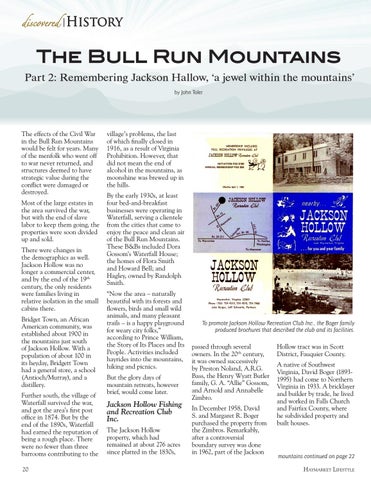discovered
History
The Bull Run Mountains Part 2: Remembering Jackson Hallow, ‘a jewel within the mountains’ by John Toler
The effects of the Civil War in the Bull Run Mountains would be felt for years. Many of the menfolk who went off to war never returned, and structures deemed to have strategic value during the conflict were damaged or destroyed. Most of the large estates in the area survived the war, but with the end of slave labor to keep them going, the properties were soon divided up and sold. There were changes in the demographics as well. Jackson Hollow was no longer a commercial center, and by the end of the 19th century, the only residents were families living in relative isolation in the small cabins there. Bridget Town, an African American community, was established about 1900 in the mountains just south of Jackson Hollow. With a population of about 100 in its heyday, Bridgett Town had a general store, a school (Antioch/Murray), and a distillery. Further south, the village of Waterfall survived the war, and got the area’s first post office in 1874. But by the end of the 1890s, Waterfall had earned the reputation of being a rough place. There were no fewer than three barrooms contributing to the 20
village’s problems, the last of which finally closed in 1916, as a result of Virginia Prohibition. However, that did not mean the end of alcohol in the mountains, as moonshine was brewed up in the hills. By the early 1930s, at least four bed-and-breakfast businesses were operating in Waterfall, serving a clientele from the cities that came to enjoy the peace and clean air of the Bull Run Mountains. These B&Bs included Dora Gossom’s Waterfall House; the homes of Flora Smith and Howard Bell; and Hagley, owned by Randolph Smith. “Now the area – naturally beautiful with its forests and flowers, birds and small wild animals, and many pleasant trails – is a happy playground for weary city folks,” according to Prince William, the Story of Its Places and Its People. Activities included hayrides into the mountains, hiking and picnics. But the glory days of mountain retreats, however brief, would come later.
Jackson Hollow Fishing and Recreation Club Inc. The Jackson Hollow property, which had remained at about 276 acres since platted in the 1830s,
To promote Jackson Hollow Recreation Club Inc., the Boger family produced brochures that described the club and its facilities.
passed through several owners. In the 20th century, it was owned successively by Preston Noland, A.R.G. Bass, the Henry Wyatt Butler family, G. A. “Allie” Gossom, and Arnold and Annabelle Zimbro. In December 1958, David S. and Margaret R. Boger purchased the property from the Zimbros. Remarkably, after a controversial boundary survey was done in 1962, part of the Jackson
Hollow tract was in Scott District, Fauquier County. A native of Southwest Virginia, David Boger (18931995) had come to Northern Virginia in 1933. A bricklayer and builder by trade, he lived and worked in Falls Church and Fairfax County, where he subdivided property and built houses.
mountains continued on page 22 Haymarket Lifestyle
